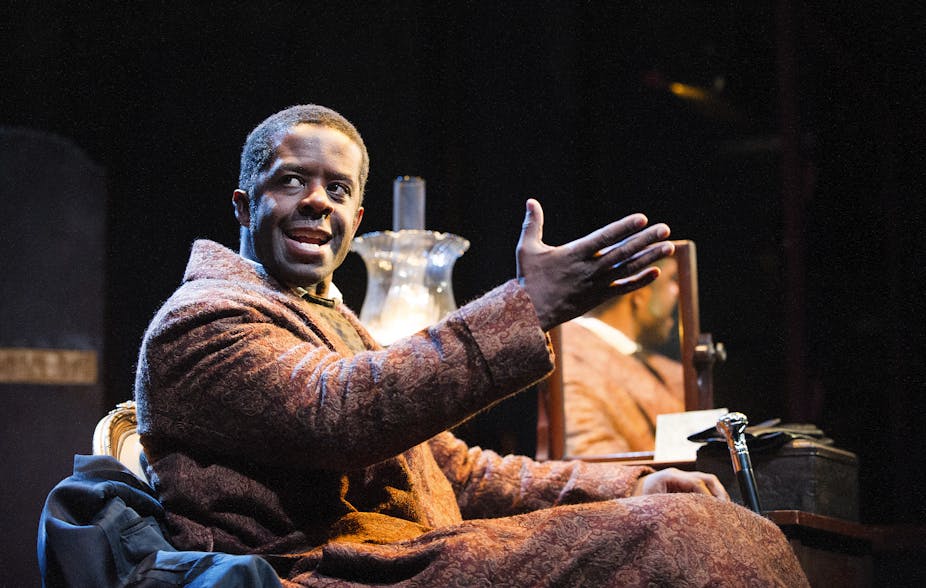In 1825 the African-American actor Ira Aldridge came to London in The Slave’s Revenge. Before abolition, he had no hopes of working on the stage at home, but he became one of the most popular Shakespearean performers in Europe and was honoured by monarchs. A century later, Paul Robeson played Othello in London because racism made it impossible in the USA. He stayed and starred in six British films.
Now we’re facing an ironic reversal. There’s been much coverage of how black British actors are triumphing on US screens, and not on those in the UK. But the opportunities in theatre also don’t exist here. I have been investigating the history and the current state of play for British black and Asian theatre artists and producers. They tell me that local audiences – white, black, Asian – have become less open to productions that don’t reflect “their” communities. I’ve heard that fewer roles are being auditioned colour-blind, and young and established actors alike have said to me, in frustration, “I’m going to have to try America”.
How did this happen?
The actor Don Warrington has said that white actors’ careers run on “tramlines” partly shaped by the classical repertoire, whereas black actors’ employment is “stop-go”. Many are shunted into the sidings of Casualty, Holby City and countless police procedurals. In 2010, an unprecedented Guardian editorial complained that David Harewood – the National Theatre’s first black Othello, 13 years previously – was being given too few stage opportunities. Showtime promptly cast him as the CIA chief in Homeland.
Last year several African-American plays and musical dramas were staged in London, including August Wilson’s Fences with Lenny Henry. Optimism grew. But as Fences’ director Paulette Randall said, “It’s history repeating itself”.
Back in 1986, Yvonne Brewster founded Talawa, Britain’s foremost black-led theatre company. She fostered brilliant black playwrights and performers and laid claim to King Lear and Oscar Wilde. Meanwhile the actress Josette Simon was working her way up through the RSC’s ranks – from playing a desert-island sprite, a witch, and Cleopatra’s handmaid – to lead the company in 1987. Then she played Maggie – Marilyn Monroe – in Arthur Miller’s After the Fall at the National. The dramatist Bonnie Greer said she moved to London from Chicago because of the achievements of Simon’s generation.
British theatre is both art and part of an industry topped by film and television that produces highly skilled practitioners but doesn’t always know how to use them. Except stereotypically.
Multi-ethnic talent – especially policy-making talent – is essential off-stage as well as on. After a 2002 report revealed that 96% of British theatre staff were white, the Arts Council launched a decade-long series of Race Equality schemes that called on all companies to draw up positive programmes. Some called this “Stalinist” but experience shows that in a “stop-go” climate isolated advances are often followed by complacency and reversals. Under the Conservative-led Government there have been disproportionately large “austerity” cuts to multicultural companies.
But committed practitioners will work with the tools available. Three leading black actors, Adrian Lester, Paterson Joseph and David Harewood, have all made TV documentaries working on Shakespeare with urban teenagers. In financially straightened times, Talawa’s current director Michael Buffong is working strategically alongside the mainstream system in the regions, with co-productions of Waiting for Godot and Miller’s All My Sons (with Don Warrington).
What is needed are artists prepared to ask inconvenient questions, which of course is traditionally the role of the writer. The American playwright Tarell Alvin McCraney has worked with and shaken up the RSC, directing Dharmesh Patel as Hamlet in a version for children: “If you’re from a minority and in the first show you see, everyone is white, a pattern builds.”
In the other direction, the Casualty actor Kwame Kwei-Armah took on the mission of dramatising a breadth of British black experiences, from street crime to the much less familiar world of politics and think-tanks. He inspired the National Theatre to create a vital database of black plays. He’s now artistic director of Baltimore’s Center Stage Theatre.
And how radically different is American theatre really?
Despite all the advances in positive discrimination from the 1960s onwards, last month Theatre for a New Audience in New York called a round-table to confront the barriers non-white performers still face. For instance, it emerged that no Romeo or Hamlet of colour has been cast by a mainstream American theatre for 35 years.
On the other hand, the very next day, the new Harlem Shakespeare Festival – created by the inspirational performer Debra Ann Byrd – commemorated the Shakespearean achievements of Aldridge, Robeson and Henrietta Vinton Davies (actress and activist: 1860-1941). The past can remind the present of what’s possible.
On March 25, Adrian Lester and a London cast will remind New Yorkers of Ira Aldridge’s bitter struggles and astonishing victories when Lolita Chakrabarti’s acclaimed play Red Velvet transfers to the St. Anne’s Warehouse in Brooklyn. Protest and celebration, British and American, must work together – because the Atlantic’s not just a lure, it’s a link.

